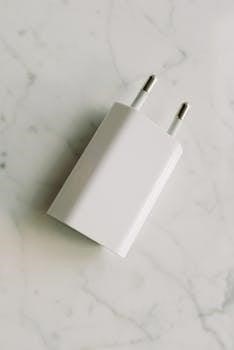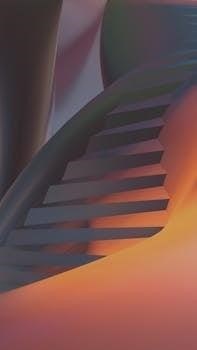Standard Spline Shaft Dimensions PDF⁚ An Overview
A comprehensive PDF overview of standard spline shaft dimensions provides essential information regarding the design and manufacturing specifications, adhering to international standards like ISO, DIN, and AGMA․
Spline shafts represent a crucial mechanical component designed for transmitting torque effectively in various applications․ Unlike keyed shafts, they feature multiple teeth or splines that mesh with a corresponding internal spline in a mating component, such as a gear or hub․ This design allows for higher torque transmission and reduced stress concentrations․
Spline shafts are commonly employed where heavy torques need to be transferred or where axial movement between components is required․ Standardization of spline shaft dimensions is vital for ensuring interchangeability, proper fit, and optimal performance․ Several international standards, including ISO, DIN, and AGMA, define these dimensions, covering aspects like pitch diameter, major diameter, minor diameter, and spline length․ Understanding these dimensions is paramount for engineers and designers to select the appropriate spline shaft for their specific applications․
Types of Splines
Splines are categorized primarily by their tooth form⁚ involute and straight-sided․ Each spline type exhibits unique characteristics impacting performance, manufacturing considerations, and applications where they are most suitable․
Involute Splines
Involute splines are characterized by teeth with an involute profile, similar to involute gears․ This design offers several advantages, including ease of manufacturing and high load-carrying capacity․ The involute form allows for smoother engagement and reduced stress concentration compared to straight-sided splines․
These splines adhere to standards like AGMA and DIN, dictating dimensions, tolerances, and fit types․ The pressure angle, pitch diameter, and number of teeth define the spline’s geometry, influencing its strength and performance․ Involute splines are commonly found in applications requiring precise power transmission, such as automotive transmissions and aerospace components․
Their self-centering capability and ability to accommodate some misalignment make them a versatile choice․ Standard dimensions for involute splines are readily available in PDF format, aiding engineers in design and selection processes․ Proper lubrication is crucial to minimize wear and ensure longevity of involute spline connections․
Straight-Sided Splines
Straight-sided splines, also known as parallel key splines, feature teeth with straight, parallel sides․ These splines are simpler to manufacture compared to involute splines, making them a cost-effective option for certain applications․ However, they generally offer lower load-carrying capacity and less precise engagement․
International standards, such as ISO 14, define the dimensions and tolerances for straight-sided splines, ensuring interchangeability and proper fit․ Key dimensions include the major diameter, minor diameter, and spline length․ These splines are often used in applications where precise alignment is not critical and where simpler manufacturing processes are preferred․
While they might not offer the same level of performance as involute splines in high-torque or high-speed applications, straight-sided splines are still widely used in various industrial settings․ PDF resources detailing standard dimensions are available, providing engineers with the necessary information for design and implementation․ Proper selection of fit types and materials is essential for optimal performance․

Key Dimensions and Terminology
Understanding spline shaft dimensions and terminology is crucial for proper design and application․ Key parameters include pitch diameter, major diameter, minor diameter, and spline length, each defined by standards․
Pitch Diameter
Pitch diameter is a fundamental dimension for spline shafts, representing the theoretical diameter where the teeth engage․ It’s the diameter of the pitch circle, crucial for calculating tooth proportions and ensuring proper fit․ This dimension is vital in determining the module and number of teeth, directly impacting the spline’s performance․
According to standards like DIN 5480, the pitch diameter is related to the module and tooth count, guiding the design of involute splines․ Accurate measurement and adherence to specified tolerances are essential for achieving the desired functional connection between the shaft and hub․ The pitch diameter influences the shear strength and overall durability of the spline connection․
Proper control and verification methods are critical for maintaining the pitch diameter within acceptable limits․ This ensures the spline connection meets the required performance and reliability standards․ It is very important for shafts and hubs․
Major Diameter
The major diameter of a spline shaft refers to the largest diameter, typically measured across the crests of the external spline teeth․ It’s a crucial dimension as it affects the overall strength and fit of the spline connection․ Standard specifications, such as those outlined in AGMA and ISO documents, provide tolerances and guidelines for the major diameter to ensure proper engagement and load distribution․
For involute splines, the major diameter is closely related to the pressure angle and tooth form, influencing the spline’s torque capacity and wear characteristics․ Careful consideration of the major diameter is essential during the design phase to prevent interference and ensure compatibility with mating components․
Variations in major diameter can impact the fit type, whether it’s a side fit or diameter fit, affecting the assembly and performance of the spline connection․ Proper measurement and adherence to specified tolerances are critical for maintaining functionality․
Minor Diameter
The minor diameter, conversely, represents the smallest diameter of the spline, measured at the root or base of the teeth on an external spline shaft․ This dimension is significant because it influences the stress concentration within the spline and contributes to its overall strength․
Standards such as DIN 5480 and ISO specifications define the minor diameter along with associated tolerances, ensuring interchangeability and proper functionality․ The minor diameter’s accurate measurement is vital for assessing the spline’s ability to withstand torsional loads without failure․
It’s also connected to the root fillet radius, which is crucial for reducing stress concentrations․ Proper design and manufacturing practices that maintain the specified minor diameter are essential for optimizing spline performance and extending its service life․ Deviations from the standard can lead to premature wear or failure․
Spline Length Considerations
Spline length is a critical parameter influencing the load-bearing capacity and stability of a spline connection․ Standard spline lengths are often chosen within the range of 0․75 to 1․25 times the pitch diameter (D)․ These standard lengths ensure that the shear strength of the splines exceeds that of the shaft itself, preventing failure․
The appropriate spline length depends on the application’s torque requirements and the materials used․ Longer splines distribute the load over a larger area, reducing stress concentrations and enhancing durability․ However, excessively long splines can increase manufacturing costs and assembly complexity․
Factors like misalignment and axial movement also play a role in determining optimal spline length․ Proper spline length selection is crucial for ensuring reliable power transmission and preventing premature wear or failure of the spline connection․

Standards and Specifications
Spline shaft dimensions are governed by various international standards, including ISO, DIN 5480, and AGMA․ These standards define the geometry, tolerances, and inspection methods ensuring interchangeability and performance in power transmission applications․
ISO Standards for Splines
ISO standards provide a framework for straight-sided splines, defining dimensions, tolerances, and verification methods crucial for cylindrical shafts with internal centering․ These standards, exemplified by ISO 14⁚1982, ensure interchangeability and proper fit․ ISO standards apply to splined connections with involute splines based on reference diameters, vital for connecting hubs and shafts in removable, sliding, or permanent fits․ These international standards lay down dimensions in millimeters, catering to light and medium series, and specify control methods and gauges, ensuring precision in manufacturing and assembly․ These standards play a critical role in maintaining uniformity and quality across various applications and industries․ They establish the tooth interlock characteristics between a shaft and hub, which is determined by the basic rack profile, the reference diameter, the module and the number of teeth․
DIN 5480 Standard
The DIN 5480 standard outlines normalized dimensions for involute splines, essential for ensuring compatibility between splined shafts and hubs․ It specifies key measurements like shaft diameter, module, and number of teeth․ The standard is a reference for splined connections utilized in removable, sliding, and permanent fits․ Designers and manufacturers consult this standard for precise dimensions․ The dimensions and modules are carefully controlled to ensure proper fit and functionality․ DIN 5480 provides a structured approach to spline design․ The standard covers various parameters, including tolerances and inspection methods․ While some dimensions are preferred, others are avoidable․ DIN 5480 ensures the reliable performance of splined connections in various applications․ It promotes consistency and interchangeability․ The standard assists in selecting appropriate components, thus streamlining the design and manufacturing process;
AGMA Standards
AGMA standards provide comprehensive guidelines for parallel straight sided and involute splines․ These standards address critical aspects like geometry, fit types, and materials․ They also cover manufacturing, rating, inspection, lubrication, and potential spline failures․ While inch-based splines are discussed, metric-based splines are detailed in AGMA 945-1-B20․ AGMA standards offer a holistic approach to spline design, ensuring optimal performance․ The standards are applicable to various applications, including coupling shafts․ The standard emphasizes the significance of proper lubrication in prolonging spline life․ AGMA standards are essential for engineers seeking to design reliable splined connections․ These standards incorporate detailed formulas for deriving spline dimensions․ Tolerances are meticulously specified to ensure proper fit and functionality․ AGMA standards play a crucial role in standardizing spline manufacturing processes․ AGMA standards are a valuable resource for achieving efficient power transmission․

Design Considerations
Careful design considerations include material selection, fit types (side fit), and stress analysis․ Proper design ensures optimal performance and longevity of the spline shaft within its intended application․
Material Selection
Selecting the appropriate material for a spline shaft is paramount, influencing its strength, durability, and resistance to wear and tear․ Typically, spline shafts are crafted from steel alloys, chosen for their high tensile strength and machinability․ Heat treatments like hardening can further enhance the material’s surface hardness, improving wear resistance and extending the shaft’s lifespan․
Considerations must include the operating environment, load conditions, and desired lifespan․ For corrosive environments, stainless steel might be a suitable option, albeit with a potential trade-off in strength․ Material selection directly impacts the spline’s ability to withstand torque, shear forces, and fatigue․
Furthermore, the chosen material should be compatible with the manufacturing processes, such as hobbing or broaching, used to create the spline teeth․ Ultimately, material selection is a critical design decision that balances performance requirements with cost-effectiveness․
Fit Types (Side Fit)
Side fit, a common type of spline connection, involves contact between the sides of the spline teeth on both the shaft and the hub․ This fit type is designated by the nominal size, number of teeth, and tolerances on effective dimensions․ In side fit splines, dimensional accuracy is crucial to ensure proper load distribution and prevent premature wear․
The effective space width for internal splines and tooth thickness for external splines are critical parameters․ Clearances are designed to allow for lubrication and thermal expansion․ Side fit splines are often used in applications where sliding motion is required, such as in gear shifting mechanisms․
Proper lubrication is vital to minimize friction and wear between the contacting surfaces․ The selection of appropriate tolerances ensures that the spline assembly meets the required performance standards․ Side fit connections are widely applied due to their balance of precision and ease of assembly․

Applications of Spline Shafts
Spline shafts serve a multitude of critical functions across various industries, primarily for transmitting torque efficiently․ In automotive applications, they connect transmissions to differentials, ensuring reliable power transfer․ Industrial machinery utilizes spline shafts in gearboxes, pumps, and other rotating equipment where high torque capacity is essential․
Aerospace engineering employs splines in aircraft engines and control systems, demanding precision and durability under extreme conditions․ Agricultural equipment, like tractors and harvesters, relies on spline shafts to drive implements and handle heavy loads․ Manufacturing processes utilize splines in machine tools and robotics, enabling accurate and powerful motion․
Spline shafts also find use in recreational vehicles, marine propulsion systems, and even medical devices, showcasing their versatility․ Their robust design allows for secure connections, handling significant torsional stress․ The choice of spline type and dimensions depends on the specific application’s requirements, ensuring optimal performance and longevity․
